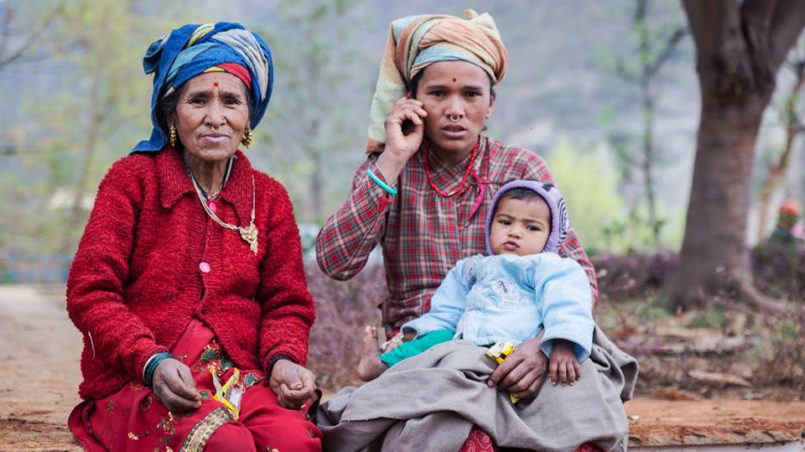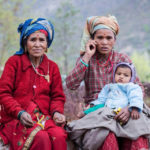The Pain of Nepalese Women

Nepal is one of the poorest countries in the world. There are slightly more females than males in Nepal. I am a public health professional and frequently travel in the countryside. During a trip to the site of my project in Lamjung, one of the rural districts of Nepal, I heard a very painful story about a Nepalese woman who suffered from a prolapsed uterus and it really touched my heart.
The story I am writing about is a representative story of the majority of Nepalese women.
Kamali Maya Tiwari lives in the Lamjung district, which lies in the western region of Nepal. She lost her mother when she was very young and, at the age of 11, she got married. She gave birth to her first child when she was 18 years old and in total she gave birth to nine children, five of whom are still alive. She is now 78 years old. All the deliveries were performed at home, which made each birth unsafe as each could have led to complications for both mother and baby, not to mention the higher risk of maternal and infant mortality.
In her late 40s, she was working in the fields near her village when she suddenly felt as if her insides were dropping out. At the time she experienced great pain.
She was confused about what had actually happened to her and told nobody, not even her children and husband, hoping that the problem would go away.
Tiwari is one of the many women who regularly go to hospitals in Nepal, seeking treatment for a prolapsed uterus, which is the main cause of ill health among women of reproductive and post-menopausal age in Nepal.
Prolapsed uteri are a major health issue in the rural areas of Nepal. There are simply no hospitals to treat the condition as it has to be treated at a more technologically advanced health facility. Rural women do not have access to these kinds of treatment facilities.
Experts have estimated that more than 500,000 women in Nepal (with a population of 30 million) suffer from a prolapsed uterus. It is one of the major causes of death among lower caste rural women. Lower caste women are considered to be the untouchable women. They are not allowed to enter the houses of higher caste people. In particular these marginalised women and underprivileged women do not have access to quality health care services.
The occurrence of prolapsed uteri is widespread In Nepal. It affects rural women of mountains, hills, plains and valleys of Nepal. Uterine prolapse occurs when pelvic floor muscles stretch and weaken and no longer provide enough support for the uterus which, as a result, slips down into or protrudes out of the vagina.
The major risk factors of uterine prolapse are age and a large number of pregnancies – however, although it can occur at any age, it often affects post-menopausal women who have one or more vaginal deliveries.
The female population of Nepal makes up slightly more than 50% of the total population of Nepal. In Nepal, sons are preferred over daughters. This is reflected in the social indicators of literacy, child mortality, maternal mortality and female mortality. Uterine prolapse is a very complex problem because, as mentioned earlier, it is often kept secret by Nepalese women because of the shame they feel about having a medical condition which affects the most imtimate and sensitive parts of a woman’s body.
I strongly believe that the prevention of uterine prolapse is essential in Nepalese communities. The major preventive measure could be to limit the number of pregnancies among Nepalese women. Health education during pregnancy is also essential as are adequate antenatal checkups and the proper nutrition of women.
Postnatal care is considered to be very poor in Nepal and it has to be improved in order to minimise the number of uterine prolapse cases. Equal opportunities for education are also essential as the school drop-out rate of Nepalese girls is very high. When the health condition of women improves, the result is a healthier family, community, nation and entire world.
Credits
| Image | Title | Author | License |
|---|---|---|---|
 |
Pain of Nepalese women | Bravo Aatma | CC BY-SA 4.0 |

Nice…
true story in Nepal. specially in hilly region of nepal. nicely described.
Nice…
Thank you..
Reflects many stories of the women of our country. I and my friend came across a 35 year old young lady who lived 13 years of her life with 3rd degree prolapse during our community field visit due to lack of access to health service, inability to reach for and identify proper health center, economical limitations, lack of knowledge about the government facilities, so and so..We had to literally push her really hard by continuous phone calls, helping to go through all the hospital procedures and visiting various administrative body to get her free surgery..Today she lives happily..Hope one day all our mothers, sisters and women out there would have access to the care they need..Let us all work to make sure that these stories won’t be the story our kids will get to hear…
Thank you Angmo..Yes we must work to prevent these female health problems.
Really good article based on Nepalese situation. Good job sir.
Thank you very very much bikram
Sounds a very true story of our country,these type of health issues remain untreated in the society because of illiteracy and poor economic limitation.All the concern parties(health professional and health related personal )should be responsible.
Yes its is a major Public health issues in developing countries.
It’s a good and an eye opening article sir.
Wonderful sir, good going..!!!!
Yes brother
reflect true hidden scenariof nepal- this facts are also true in urban area- while working as a facilitator for the earthquake victims women of lamataar VDC for UP session I realized the importance of male participation and support on this.kegel exercises and pelvic strenthening programs would be great help too.
A beautiful insight to one of the major health problem in MCH faced in underdevelop country like ours. The socio-cultural and economic stigma women facing, can be beautifully interpreted with this article.
An excellent writing. Thank you sir for the insight!
really impressive… a touched story.
” Women needs to be understood as they are not only the integral part of creation but also contributers of creation “,I strongly believe this statement .This article has highlighted on such health topic which is serious health problem which adversely effects/had effected women’s health .Due to illiteracy ,negligence and ignorance this health problem has been shadowed on secret side where public can hardly reach .By highlighting the real life story, ur article has done great job mama.Now public can not only get awareness regarding this topic but also, can feel the pain of every women out there. Great article 👍
“Womens need to be understood as they are not only the integral part of creation but also contributers of creation “.THis article has highlighted on such health topic which is serious health problem which adversely had effected /effects on women health. Due to illiteracy, negligence and ignorance this health problem has been shadowed on secret side where public can hardly reach. By highlighting the real life story, your article has done great job mama. Now, public can not only get awareness regarding this topic but also, can feel the pain of every women out there. Great article 👍
Really very nice articles flashing the light on reality of the health situaton of the rural women.
I believe not only women in distant parts of Nepal but also in the Kathmandu: capital city has the higher prevalence of UP (Uterine Prolapse). While conducting Health Education programs at different parts of Kathmandu I found this shocking fact. I believe UP is a health issue that reflects comprehensive social problem of Nepal.
Yes it’s so true women in Nepal are very conservative about Sexual health. Most common problem is very less knowledge about post partum delivery. Health and well-being of a the mother is as much as important as new born. So i guess health workers should give some attention to the physical and mental health of the mother too for about 3-6 months. That way there is a very less risk of poor women health even they are illiterate. A close supervision and more education regarding sexual health is most important to improve health of women in rural parts of Nepal.
Really good article sir..nice one !!
great job sir …excellent written true story of mostly hilly reason of nepal
True story.. nice work..
Really very nice article sir
It’s major issue of public health
Nice article! reflects the reality of Nepalese women, mostly who lives in rural area. Keep on sharing such experience ..
Real and touched story of remote part of our country.
Nice
Need to conduct more awareness programme focusing both child and mother regarding preventive health.
Good survey and article to know about the health issues faced by people where there is no access of health care facilities.